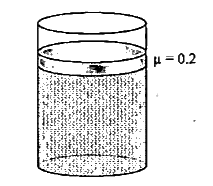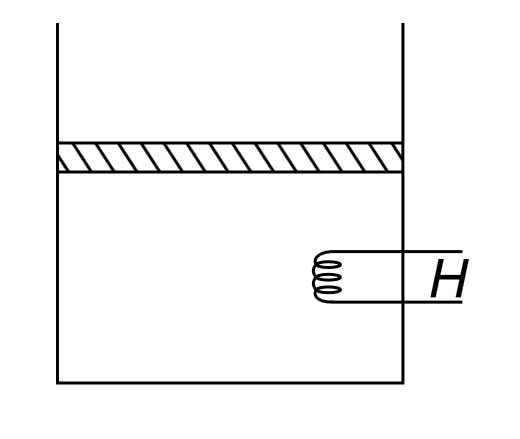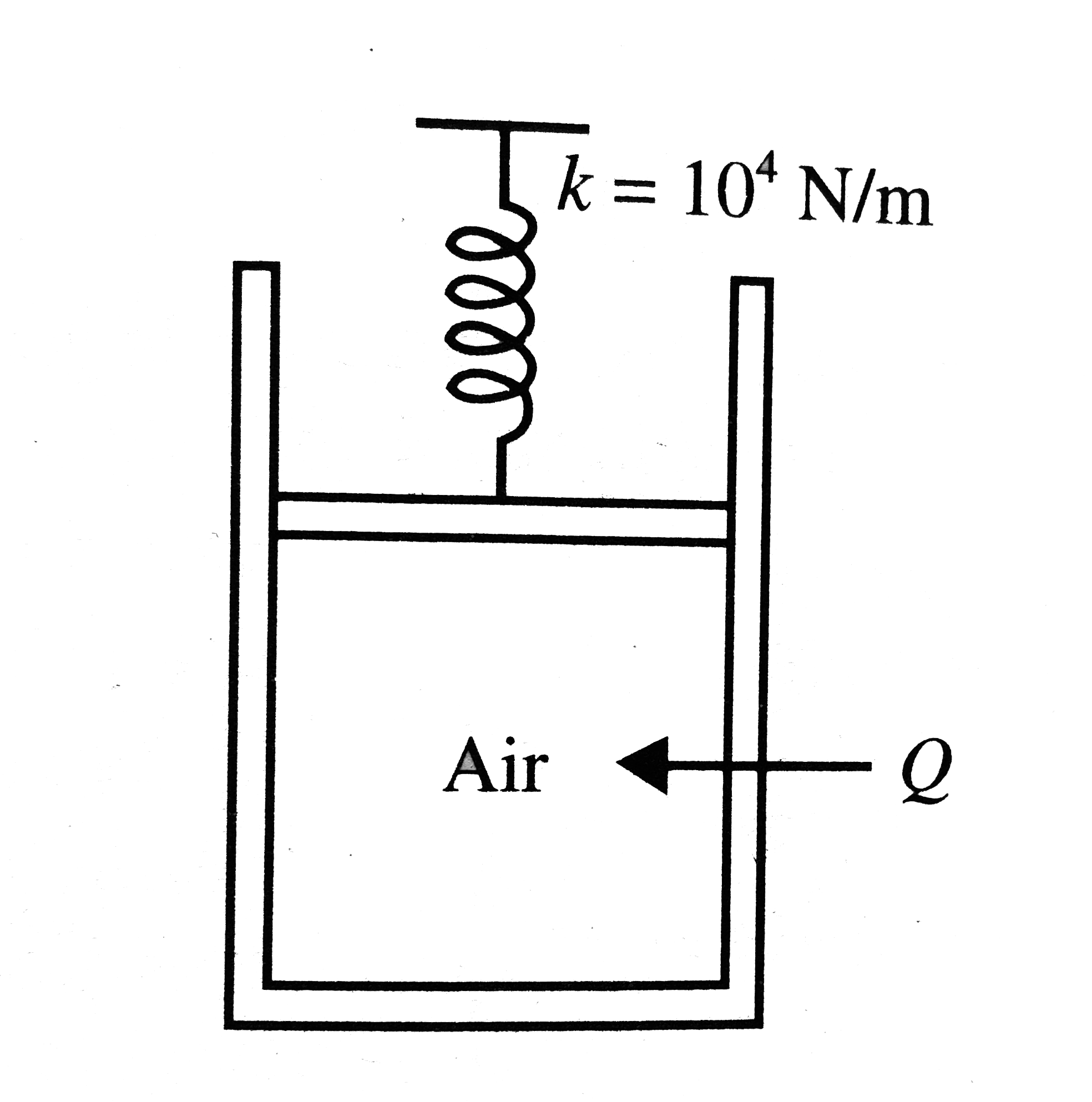A piston/cylinder assembly contains 1 kg of liquid water at 20°C and 300 kPa. There is a linear spring mounted on the piston such that when the water is heated the pressure reaches 1 MPa with a volume of 0.1 m3. Find the final temperature and the heat transfer in the process.
Take CV as the water. m2 = m1 = m ;mu2 − u1 = 1Q2 - 1W2 State 1: Compressed liquid take saturated liquid at same temperature.
Related Solutions
A frictionless piston-cylinder based enclosure contains some amount of gas at a pressure of 400 kPa. Then heat is transferred to the gas at constant pressure in a quasi-static process. The piston moves up slowly through a height of 10 cm. If the piston has a cross-sectional area of 0.3 m^(2) , the work done by the gas in this process is
View SolutionFigure-2.47 shows a cylindrical container of radius 5cm and a piston is fitted in it to enclose a length of 20 cm in it.The cylinder contains an ideal gas at a pressure of 1 atmosphere and 300 K temperature.The cylinder is slowly heated and it is found that the piston starts displacing when the gas temperature reaches 600 K. It is given that the friction coefficient between the piston sidesand the container wall is 0.2. Find the normal force acting between piston sides and the container wall per unit length ofits circumference.
 View Solution
View Solution400 kPa दाब पर एक घर्षणरहित पिस्टन युक्त बेलन में गैस की कुछ मात्रा है तत्पश्चात् कवासी-स्थैतिक प्रक्रम में नियत दाब पर गैस को ऊष्मा स्थानांतरित की जाती है। पिस्टन धीरे -धीरे 10 cm की ऊँचाई तक विस्थापित हो जाता है। यदि पिस्टन का अनुप्रस्थ परिच्छेद क्षेत्रफल है, तब इस प्रक्रिया में गैस द्वारा किया गया कार्य है
View SolutionThe pressure of a gas contained in a cylinder with a movable piston is 300 Pa. The area of the piston is 0.5 m2. Calculate the force that is exerted on the piston.
View SolutionThe pressure of a gas contained in a cylinder with a movable piston is 300 Pa. The area of the piston is . Calculate the force that is exerted on the piston.
View SolutionAir is contained in a vertical piston – cylinder assembly fitted with an electric heater. The piston has a mass of 50 kg and cross sectional area of . Mass of the air inside the cylinder is 0.3 kg. The heater is switched on and the volume of the air slowly increases by . It was found that the internal energy of the air increased by and that of the piston increased by 0.06 kJ/kg. Assume that the container walls and outer surface of the piston are well insulated and there is no friction. The atmospheric pressure is 100 kPa. Determine the heat transferred by the heater to the system consisting of air and the piston.
 View Solution
View SolutionA cylinder containing nitrogen gas and some liquid water at a temperature of . The total pressure in the cylinder is 600 mm. The piston is moved into the cylinder till the volume is halved keeping the temperature constant. If the aqueous tension at is 23.8 mm, calculate the final total pressure in the cylinder.
View SolutionA cylinder containing nitrogen gas and same liquid water at a temperature of 25^(@)C . The total pressure n the cylinder is 600 mm. The piston is moved into the cylinder til the volume is halved keeping the temperature constant. If the aqueous tension at 25^(@)C is 23.8 mm, calculate the final total pressure in the cylinder.
View SolutionWater of mass is enclosed in a thermally insulated cylinder at the temperature of under a weightless piston whose area is . The outside pressure is equal to standard atmospheric pressure. To what height will the piston rise when the water absorbs of heat ?
View SolutionAir is contained in a piston-cylinder arrangement as shown in Fig. with a cross-sectional area of 4 cm^(2) and an initial volume of 20 cc . The air is initially at a pressure of 1 atm and temperature of 20^(@)C . The piston is connected to a spring whose spring constant is k = 10^(4) N//m , and the spring is initially underformed. How much heat must be added to the air inside cylinder to increase the pressure to 3 atm (for air, CV = 718 J//kg.^(@)C , molecular of air 28.97)?
View SolutionAir is contained in a piston-cylinder arrangement as shown in Fig. with a cross-sectional area of and an initial volume of . The air is initially at a pressure of 1 atm and temperature of . The piston is connected to a spring whose spring constant is , and the spring is initially underformed. How much heat must be added to the air inside cylinder to increase the pressure to 3 atm (for air, , molecular of air 28.97)?
 View Solution
View SolutionAvertical hollow cylinder contains an ideal gas. The gas is enclosed by a 5 kg movable piston with area of cross section . Now the gas is heated from 300 K to 350 K and the piston rises by 0.1 m. The piston is now clamped at this position and the gas is cooled back to 300 K. Find the difference between the heat energy added during the heating process and the energy lost during the cooling process.
View SolutionA cylinder contains nitrogen gas and a small amount of liquid water at a temperature 25^(@)C . (The vapour pressure of water is 23.8 mm Hg.) The total pressure is 600 mm Hg. A piston is pushed into the cylinder until the volume is halved. What is the final total pressure?
View SolutionA cylinder contains nitrogen gas and a small amount of liquid water at a temperature C. (The vapour pressure of water is 23.8 mm Hg.) The total pressure is 600 mm Hg. A piston is pushed into the cylinder until the volume is halved. What is the final total pressure? (In atm)
View SolutionA cylinder fitted with movable piston contains liquid water in equilibrium with water vapour at 25°C. Which operation would result in a increase in the equilibrium vapour pressure.
View SolutionA cylinder fitted with a movable piston contains liquid water in equiliberium with water vapour at 25^o C . Which operation result in a decrease in the equiliberium vapour pressure ?
View SolutionA cylinder fitted with movable piston contains liquid water in equilibrium with water vapour at 25°C. Which operation would result in a increase in the equilibrium vapour pressure.
View SolutionA cylinder fitted with a movable piston contains liquid water in equilibrium with water vapour at 25^(@)C . Wich operation result in a decrease in the equilibrium vapour pressure ?
View Solutioncylinder fitted with a movable piston contains liquid water in equilibrium with water vapour at 25^(@)C . Which operation result in a decrease in the equilibrium vapour pressure?
View SolutionThe saturated water vapour is enclosed in a cylinder under a piston and occupies a volume of 5 litres at . Find the mass oif th water formed after the volume under the piston is decreased to litres at the same temperature.
View Solution
